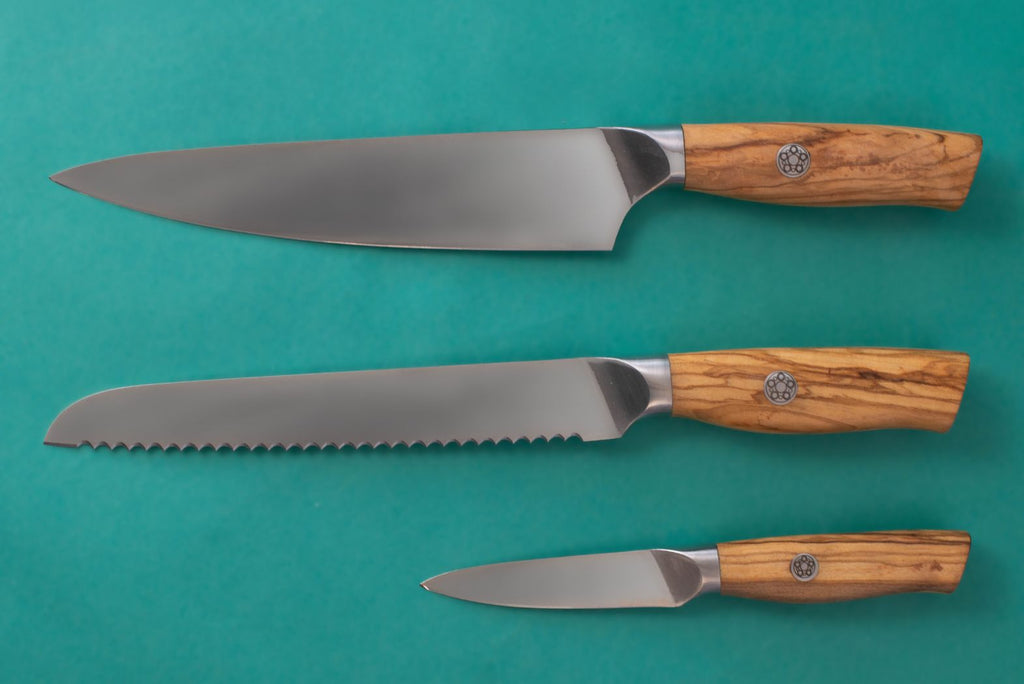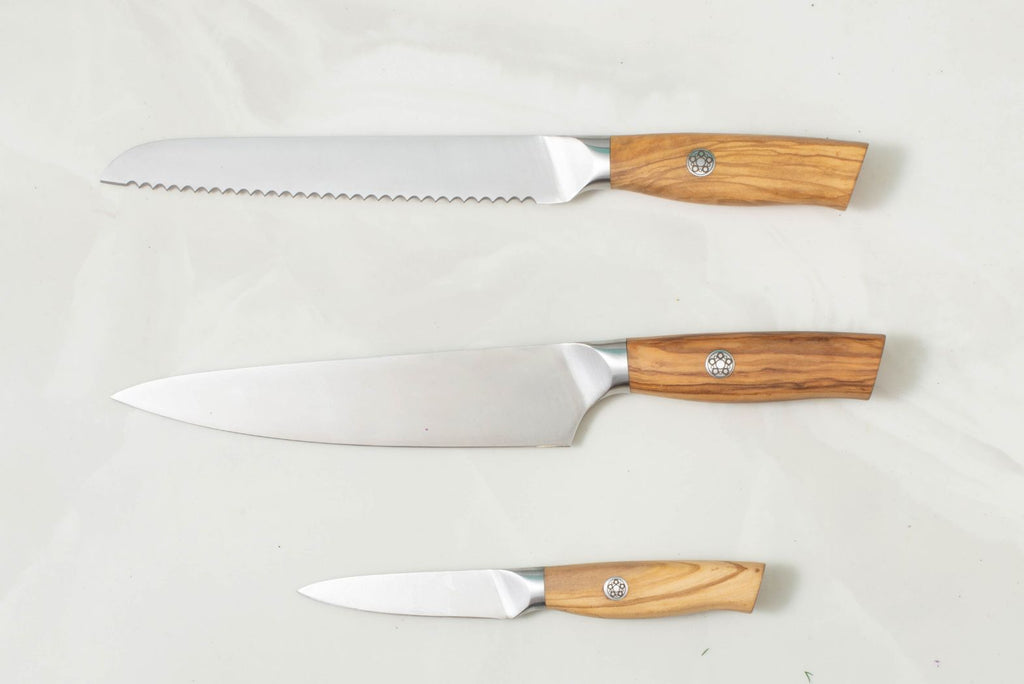What Knives Do You Need in Your Kitchen
by Kristin Lohse

Do you really need different knives for different jobs in the kitchen? Yes!
In this blog we will discuss:
- What are the 3 most important knives in a kitchen?
- What size kitchen knives should I need?
- Do you need more than one kitchen knife?
Whether you're a seasoned chef or a home cook, understanding the purpose and proper use of each knife can transform your kitchen experience.
Sous Chef knife experts
In this guide, you’ll hear from Sous Chef buyer Kristin Lohse, who has many years of kitchen knife experience - and is a true expert in sharpening and caring for knives. And Sous Chef food editor Holly Thomson, who has been trained in knife skills by expert chefs and cookery teachers.
Plus Sous Chef founder Nicola Lando will share her insight and expertise. Nicola has worked in a Michelin kitchen, and knows first-hand which are the knives top chefs love. She also has over a decade of experience talking to knife makers, small producers and artisan kitchen knife brands, from around the world.
If you want to browse more about kitchen knives, check out our kitchen knives collection, or read our guides to What Are The Best Kitchen Knives and How To Sharpen Kitchen Knives.
What are the 3 most important knives in a kitchen?
You may wonder, how many knives do you need in the kitchen and which are the important ones that you should have? At the core, these three key kitchen knives can serve the majority of your needs:
Chef’s knife
The chef's knife, with its versatile design, is ideal for tasks such as chopping vegetables, slicing meats, and mincing herbs. An 8-inch chef's knife, like the Messermeister Olivia Luxe, provides a balanced mix of control and power. Its size and shape allow for efficient handling of a wide range of food items, making it a go-to tool for daily meal prep.
Paring knife
For more delicate or intricate tasks, a paring knife steps in. This small but mighty knife excels at peeling fruits, deveining shrimp, and other precise work where a larger blade would be cumbersome. The Opinel Parallele Beech Handle Paring knife is a perfect example, offering precision and ease of control for detailed cutting tasks.
Serrated knife
A serrated knife, often overlooked, is crucial for cutting through bread and other foods with a hard exterior and soft interior without crushing them. The Messermeister ‘Custom Chef’ offset bread knife showcases how a serrated edge efficiently saws through crusty loaves, ensuring clean slices with minimal effort.

While these three knives cover the basics, certain cooking styles or preferences might require additional kitchen knives: boning knife or a santoku knife for instance.
Boning knife
A boning knife is essential for those who frequently prepare fish or meat and require a strong blade for separating meat from bone. Boning knives are generally are a bit thicker than a chef's knife and have a pointed tip to make it easy to cut around bones.The Japanese AUS10 Boning Knife, 16.5cm provides the precision needed for such tasks.
Santoku knife
A Santoku knife is another valuable addition for those who appreciate its versatility in slicing, dicing, and chopping, especially for vegetable-heavy diets.
What size kitchen knives should I need?
Selecting the right size for kitchen knives depends on the jobs you regularly perform and the size of the food items you usually handle.
Consider the scale of the ingredients you most frequently handle and your comfort level.
- Larger knives can handle bigger tasks more efficiently but may feel cumbersome to some users.
- Smaller knives offer control and precision but may not be as efficient for larger tasks.
Best size for chef’s knives
The chef's knife, often considered the kitchen's all-rounder, typically comes in lengths from 6 to 12 inches. An 8-inch chef's knife strikes a balance between manoeuvrability and the strength to handle a broad range of tasks, from chopping vegetables to slicing meats.
Best size for paring knives
A paring knife, designed for precision tasks such as peeling and trimming, usually measures between 3 and 4 inches. This size allows for intricate work without the bulk of a larger knife getting in the way.
Best size for santoku knives
The Santoku knife, a Japanese alternative to the chef's knife, is shorter, with most blades around 5 to 7 inches. This size is ideal for those who prefer a lighter knife for chopping, dicing, and slicing.

Do you need more than one kitchen knife?
“A knife collection is a very personal thing and can't really be generalised.”
Yes, having more than one kitchen knife is essential for handling different culinary tasks efficiently and safely. And you might also want to customise your knife collection…
Sous Chef knife buyer Kristin says:
“Me personally, I prefer using 7-8in Chef's knife /Santokus /Gyuto knives for most of the tasks in my kitchen. So I have a selection of those that get frequently used.
I have only one paring knife as I don't use it very often, and I have a bread knife. I also have a fish filleting knife as we eat quite a lot of fish.
I do have a couple of 6 inch utility and chef's knives as my partner prefers using slightly smaller knives.
If you're not sure what you'd use most, start with the core trio: A version of a chef's knife at your preferred size, a paring knife and a bread knife. From there you can build out your collection based on what knives you use most or what you feel you are missing for your tasks.
A knife collection is a very personal thing and can't really be generalised. Custom build your collection to suit your style of cooking.”
To continue reading, check out our blog on How To Care For Your Knives.

About the author
Kristin is the Purchasing and Buying assistant at Sous Chef. She has several chefs and excellent home cooks in her family, and grew up in the kitchen in Sweden. Cooking and baking with her mum happened pretty much every day. Cinnamon rolls were always stocked up in the freezer, and if they were running low, more baking had to be done. Kristin always loves learning more about food and ingredients to continue improving her skills.


